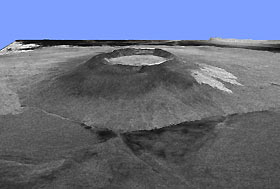
Save this image free of charge
in 800 pixels for layout use
(right click, Save as...)
|
|
Ref : V01913
Theme :
Looking at Earth - Volcanos (181 images)
Title : Space Radar Image Isla Isabela in 3-D
Caption :
This is a three-dimensional view of Isabela, one of the Galapagos Islands located off the western coast of Ecuador, South America. This view was constructed by overlaying a Spaceborne Imaging Radar-C/X-band Synthetic Aperture Radar (SIR-C/X-SAR) image on a digital elevation map produced by TOPSAR, a prototype airborne interferometric radar which produces simultaneous image and elevation data. The vertical scale in this image is exaggerated by a factor of 1.87. The SIR-C/X-SAR image was taken on the 40th orbit of space shuttle Endeavour. The image is centered at about 0.5 degree south latitude and 91 degrees west longitude and covers an area of 75 by 60 kilometers (47 by 37 miles). The radar incidence angle at the center of the image is about 20 degrees.The western Galapagos Islands, which lie about 1,200 kilometers (750 miles) west of Ecuador in the eastern Pacific, have six active volcanoes similar to the volcanoes found in Hawaii and reflect the volcanic processes that occur where the ocean floor is created. Since the time of Charles Darwin's visit to the area in 1835, there have been more than 60 recorded eruptions on these volcanoes. This SIR-C/X-SAR image of Alcedo and Sierra Negra volcanoes shows the rougher lava flows as bright features, while ash deposits and smooth pahoehoe lava flows appear dark. Vertical exaggeration of relief is a common tool scientists use to detect relationships between structure (for example, faults, and fractures) and topography.Spaceborne Imaging Radar-C and X-Synthetic Aperture Radar (SIR-C/X-SAR) is part of NASA's Mission to Planet Earth. The radars illuminate Earth with microwaves allowing detailed observations at any time, regardless of weather or sunlight conditions. SIR-C/X-SAR uses three microwave wavelengths: L-band (24 cm), C-band (6 cm) and X-band (3 cm). The multi-frequency data will be used by the international scientific community to better understand the global environment and how it is changing. The SIR-C/X-SAR data, complemented by aircraft and ground studies, will give scientists clearer insights into those environmental changes which are caused by nature and those changes which are induced by human activity.SIR-C was developed by NASA's Jet Propulsion Laboratory. X-SAR was developed by the Dornier and Alenia Spazio companies for the German space agency,Deutsche Agentur fuer Raumfahrtangelegenheiten (DARA),and the Italian space agency, Agenzia Spaziale Italiana (ASI).
|
|

